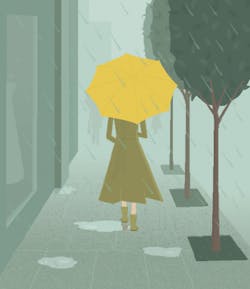Editor’s Comments: Rainwater Capture, Water Pollution, and Agricultural Growth
I remember what it was like being a kid on a moderately rainy day, walking around the neighborhood sidewalks in rubber boots, swinging my umbrella and feeling that wondrous feeling that must be unique to human beings: being in the natural world but my comfort not determined by nature’s whims. I had shelter (even more so when those big bubble umbrellas were in fashion), so I could stretch my hand out to touch the raindrops, but they couldn’t touch me.
But that is only half the story. Nature wins sometimes; it foils our best-laid plans. We engineer our outposts in the wilderness, build them to become towns and cities, and then encounter nature’s countermoves. But in no time, we think up adjustments, and we engineer again.
There were no waterfalls where I grew up in central New Jersey, but on those rainy days you could listen as the water ran along the roof, through gutters, down storm drains, and then follow the flow down the driveway to the edge of the street; you could hear it roaring into sewers. As kids we would send twigs down in these streams until they’d tumble over the falls through the metal grates.
In 1970, Joni Mitchell sang about the environmental tradeoffs that occurred because “they paved paradise and put up a parking lot,” and 40 years later more and more cities are beginning to address the problems that have arisen due to paving over large swaths of the earth’s surfaces. Lyn Corum’s article, “Greening the Urban Water Supply” notes, among profiles of four regions making changes toward tighter compliance with the Clean Water Act, “In 2010, the city of San Francisco passed a stormwater ordinance that requires all new or redevelopment projects that disturb 5,000 feet of ‘ground plain’ to manage a certain amount of stormwater on the site; they must submit a control plan to choose among several options such as a bioretention basin or rain water gardens.”
In Seattle, the program to address these things, motivated by the need to halt urban pollution running into the Puget Sound, is called RainWise. “The RainWise program teaches customers how to emulate the once primal forest where falling rain was slowed by needles and leaves and slowly soaked into spongy soils held together by the roots of trees and plants; though RainWise takes a modern approach. Now rain gardens, cisterns, porous pavement, composting and mulching, and planting trees can repeat, at least partially, what the primal forest once did.”
Since water running over pavement and into sewage systems cannot percolate back into the ground to recharge aquifers, watersheds are disrupted. And human processes affect groundwater in other ways, too.
We’ve gotten some rain in California recently, but minds have been parched with worry while trying to figure out what plans B, C, and D will be if three years of drought turn into four. Or more. Barbara Hesselgrave writes about the economic impact of this drought and its national implications, as California is the largest agricultural producer in the country.
Hesselgrave includes the impressive history of farming in the Golden State, with its fertile soil and profuse sunlight that make for a year-round growing season. It only made sense for the pioneering inhabitants in the early days of electricity to do what it took to get at the abundant groundwater: “Farmers used electricity to expand their access to water and developed what is believed the world’s first electric irrigation pump in the Central Valley at the end of the 1890s, and between 1910 to 1940 California accounted for an estimated 70% of the entire nation’s agricultural pumps.”
Fast-forward to today when some California wells are running dry and groundwater depletion is a worldwide problem. Dr. Yoshihede Wada At University of Utrecht has published a study concluding that nonrenewable groundwater abstraction contributed approximately 20% to gross global irrigation water demand in the year 2,000. Meanwhile agricultural growth has additional downsides, one of the most significant being the devastating impacts its nutrient-laden discharges have on our waterways. Dan Rafter examines the sickening algae blooms in Toledo, OH, last summer and our Reader Profile is of Harbans Lal, environmental engineer with the USDA, who has developed a Web-based tool to help agricultural producers understand water quality.
Man against nature is not a new story. We need some relief in the midst of the struggle, and it is no surprise that the human experience is full of songs and imagery representing rain, since soft rain feels liberating and hard rain stops us in our tracks—or at least slows us down and reminds us we’re not entirely in charge.
Nancy Gross is the editor of Water Efficiency.
